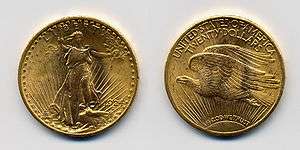Hard money (policy)


Hard money policies (as opposed to fiat currency policies) support a specie standard, usually gold or silver, typically implemented with representative money.
In 1836, when President Andrew Jackson's veto of the recharter of the Second Bank of the United States took effect, he issued the Specie Circular, an Executive order that all public lands had to be purchased with hard money.
One can say that a hard money policy is one in which the government recognizes currency which is based on an actual, fixed item which is considered valuable. Hard money is considered the opposite of fiat money, which is currency that takes its value from the government declaration or law which assigns the said value to it.[1] As such, this kind of money is not inherently valuable, but may be used in transactions as long as it is said to be legal tender. The use of fiat money is now more common than the use of hard money, especially on an international level. The US dollar, for instance, is an example of a fiat currency.
Bentonian currency
In the US, hard money is sometimes referred to as Bentonian, after Senator Thomas Hart Benton, who was an advocate for the hard money policies of Andrew Jackson. In Benton's view, fiat currency favored rich urban Easterners at the expense of the small farmers and tradespeople of the West. He proposed a law requiring payment for federal land in hard currency only, which was defeated in Congress but later enshrined in an executive order, the Specie Circular.[2]
See also
- Bullion coin
- Digital gold currency
- Fractional reserve banking
- Gold standard
- Hard currency
- Hard money (disambiguation)
- Libertarianism
References
- ↑ "Fiat money definition". Retrieved 2012-08-20.
- ↑ Violette, Eugene (1918). History of Missouri. New York: D.C. Heath & Co. p. 275.
Further reading
- How Gold Coins Circulated in 19th Century America David Ginsburg
- North, Douglas C. (1966). The Economic Growth of the United States 1790-1860. New York, London: W. W. Norton & Company. ISBN 978-0-393-00346-8.